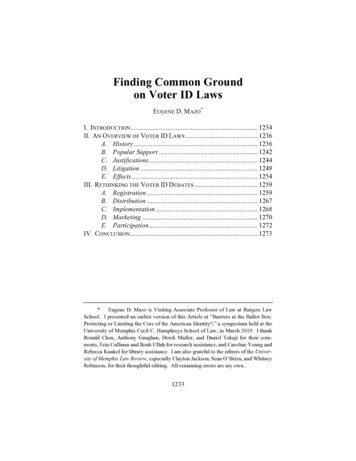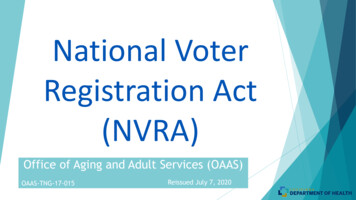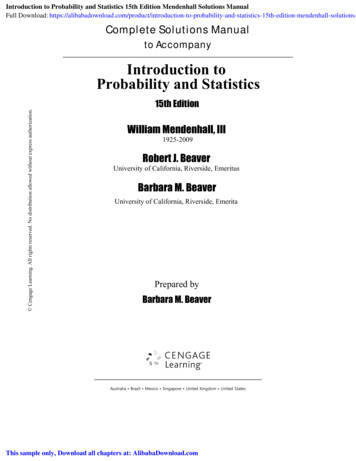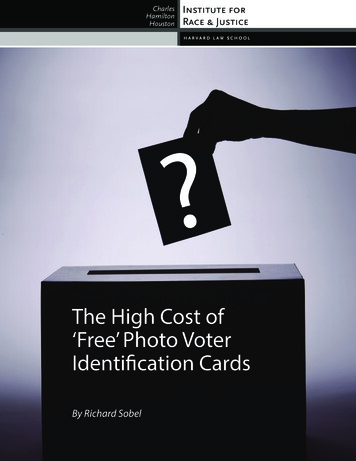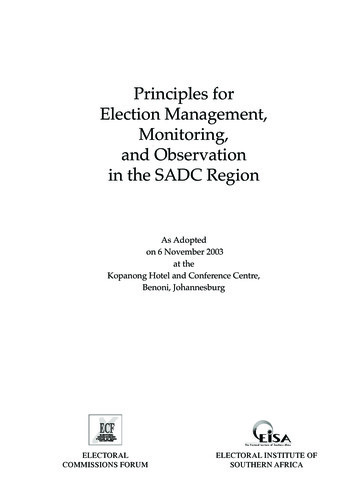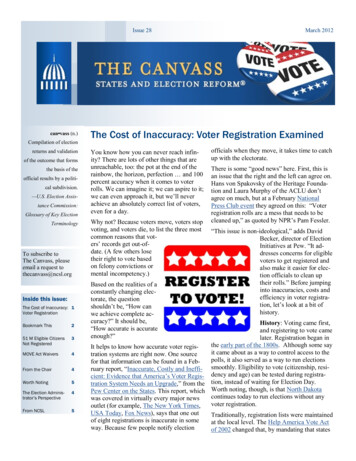
Transcription
Issue 28March 2012NCSL: The CanvassNCSL: The Canvasscan vass (n.)Compilation of electionreturns and validationof the outcome that formsthe basis of theofficial results by a political subdivision.—U.S. Election Assistance Commission:Glossary of Key ElectionTerminologyTo subscribe toThe Canvass, pleaseemail a request tothecanvass@ncsl.orgInside this issue:The Cost of Inaccuracy: 1Voter RegistrationBookmark This251 M Eligible CitizensNot Registered3MOVE Act Waivers4From the Chair4Worth Noting5The Election Administrator’s Perspective4From NCSL5The Cost of Inaccuracy: Voter Registration ExaminedYou know how you can never reach infinity? There are lots of other things that areunreachable, too: the pot at the end of therainbow, the horizon, perfection and 100percent accuracy when it comes to voterrolls. We can imagine it; we can aspire to it;we can even approach it, but we‟ll neverachieve an absolutely correct list of voters,even for a day.Why not? Because voters move, voters stopvoting, and voters die, to list the three mostcommon reasons that voters‟ records get out-ofdate. (A few others losetheir right to vote basedon felony convictions ormental incompetency.)Based on the realities of aconstantly changing electorate, the questionshouldn‟t be, “How canwe achieve complete accuracy?” It should be,“How accurate is accurateenough?”officials when they move, it takes time to catchup with the electorate.There is some “good news” here. First, this isan issue that the right and the left can agree on.Hans von Spakovsky of the Heritage Foundation and Laura Murphy of the ACLU don‟tagree on much, but at a February NationalPress Club event they agreed on this: “Voterregistration rolls are a mess that needs to becleaned up,” as quoted by NPR‟s Pam Fessler.“This issue is non-ideological,” adds DavidBecker, director of ElectionInitiatives at Pew. “It addresses concerns for eligiblevoters to get registered andalso make it easier for election officials to clean uptheir rolls.” Before jumpinginto inaccuracies, costs andefficiency in voter registration, let‟s look at a bit ofhistory.History: Voting came first,and registering to vote camelater. Registration began inthe early part of the 1800s. Although some sayIt helps to know how accurate voter regisit came about as a way to control access to thetration systems are right now. One sourcepolls, it also served as a way to run electionsfor that information can be found in a February report, “Inaccurate, Costly and Ineffi- smoothly. Eligibility to vote (citizenship, resicient: Evidence that America‟s Voter Regis- dency and age) can be tested during registratration System Needs an Upgrade,” from the tion, instead of waiting for Election Day.Pew Center on the States. This report, which Worth noting, though, is that North Dakotacontinues today to run elections without anywas covered in virtually every major newsvoter registration.outlet (for example, The New York Times,USA Today, Fox News), says that one outTraditionally, registration lists were maintainedof eight registrations is inaccurate in someat the local level. The Help America Vote Actway. Because few people notify electionof 2002 changed that, by mandating that states
NCSL: The CanvassNovember/DecemberMarch2011 2012The Cost of Inaccuracy: Voter Registration Examinedcreate statewide registration databases. Almost all stateshave now done so in one form or another, although California has not yet completed its new system.Wyoming, for example, created WyoReg in 2008. It‟smore than a voter registration system; it is an electionmanagement system, says state election director PeggyNighswonger. This real-time system is managed by thesecretary of state‟s office, but data are entered by localofficials throughout the state. If a voter moves within thestate, the minute she registers in her new county, her former county will know that she‟s moved. The system alsoautomatically checks registrations against felon records,death records and motor vehicle records. “We have nothad a problem with voter registration,” says Nighswonger.Wyoming, which uses Election Day registration, is required by statute to purge inactive voters from the voterregistration rolls following each general election. Countyclerks send notifications to those who didn‟t vote, sayingthat unless they send the notice back within 20 days, theirnames will be removed from the voter rolls. If they wantto vote again, they simply re-register.It‟s a good system, one that local officials have come tolove. And yet, what if a Wyoming resident moves out ofstate? Or, dies out of state?That‟s a question that the “Inaccurate, Costly and Inefficient” report tackles. We‟ll discuss these three concernsone at a time.Inaccuracies: Inaccurate voting rolls have several negative consequences. An estimated “2.2 million votes werelost because of registration problems,” according to aCalTech/MIT report, 2008 Survey of the Performance ofAmerican Elections. Election Day, then, may be a surprise and disappointment for those voters and a headachefor election administrators. Inaccuracies also underminevoter confidence and provide fodder for partisan bickering.With issues such as these, everyone wants voter registration rolls to be as clean as possible. Over the last severalyears, many states, including Wyoming, have made greatcont‟d from p. 1(strides in data-matching. A 2009 state-by-state reportcalled Maintenance of State Voter Registration Lists by theNational Association of Secretaries of State describes thework involved.Sometimes lawmakers have had to pass enabling legislationso that these in-state systems can share data across agencylines; in other states, this has been accomplished by administrative directives.With the right legislation and adaptation on the part of administrators, it also is possible for states to check their voterregistration data with information that comes from nationalsources, such as the Social Security Administration or theU.S. Postal Service.Some states exchange their lists with neighbors; one example is the “interstate cross-check program” that began withfour Midwest states in 2006. This voluntary program compares the voter registration lists of participating states to“clean up double registrations, and respond to any casesthat look like double votes,” says Brad Bryant, Kansas‟State Elections Director, who manages the program. In2012, 15 states are participating.Starting this summer, a new data center that is the result ofcollaborations between election officials, researchers, technology experts and the Pew Center on the States comesonline. It will compare registration lists with a wide varietyof data sources, and use proven data-matching techniquesand security protocols to ensure accuracy and security. Sofar, Colorado, Delaware, Maryland, Nevada, Oregon, Utah,Virginia and Washington are on board. The 2010 Pew report, Upgrading Democracy: Improving America‟s Elections by Modernizing States‟ Voter Registration Systems,provides more details about how this will work. Two concerns come up:Will this new data-matching effort automatically remove voters from the rolls? No—the system will provide reports to the states, and with that information,state or local election officials can reach out to votersand make sure they are registered accurately.How secure will citizens’ information be in this pro-Bookmark This.Page 2The blog, Election Diary, written by Brian Newby, the election commissioner for Johnson County, Kan., details one“election geek‟s” thinking on all things related to elections—except who the winners and losers will be on ElectionDay. He‟s writing for an audience of other election administrators, but he does so in a way that anyone can understand. He even makes his work sound fun.
NCSL: The CanvassNovember/DecemberMarch2011 2012The Cost of Inaccuracy: Voter Registration Examinedject? “You always want to dothis in a way that protectsprivacy, and that‟s how it hasbeen done,” says Pew‟sBecker. The Center for Democracy and Technology, aleading nonprofit organization in the field of Internetprivacy and security, hasworked on the data centerDavid Becker, Director of Pewfrom the very earliest stagesCenter on the States’ ElectionIniativesand is still part of the process.Its assessment of privacy issues is found in the report, “Pew‟s Upgrading VoterRegistration Design.”Cost: Inaccuracies on voter rolls translate into highercosts, especially for local jurisdictions. Notificationcards, voter information packets and even whole ballotsare printed and mailed to everyone on the list, whetherthey are still living at the same address or not. Somestates reduce these costs by creating “inactive” lists fornames on “undeliverable” returned mail. New Jersey isone of these states; when mail is returned as“undeliverable,” it sends one forward-able notice to thevoter. Between checking with other data sources withinthe state, plus the mail responses, Bob Giles, director ofNew Jersey‟s Division of Elections, says he‟s “verycomfortable in our approach to keeping our rolls clean.”Wasted mailings are just one costly result of inaccurateand inefficient voter rolls. The cost of handling returnedmail, fixing errors and maintaining registration databases add up. Overall, the cost of registration accountscont‟d from p. 2(for one-third of election-related expenses, according to anearlier CalTech/MIT report, “Voting: What Is/What CouldBe.” On a per-voter basis, costs tend to be higher in sparselypopulated states such as Wyoming, where centralized work,such as maintaining the database, is spread over few voters:270,083 at the time of the 2010 general election.Efficiency: Poll workers can attest to the fact that inaccuraterolls take their toll on efficiency on Election Day. Poor dataslow down the check-in process and lengthen voter lines(and raise voters‟ ill tempers). Election administrators feelthe inefficiencies well before Election Day, too; if registrations are paper-based, errors in data entry are more likelyand require staff time to fix. Spreading out registration work,instead of bunching it shortly before Election Day whenelection officials are the busiest, may be a more efficient(and more accurate) use of office resources.In 2012, lawmakers in Georgia, Hawaii, Massachusetts,Michigan, Minnesota, Nebraska, New York, North Carolina,South Carolina, West Virginia and Wisconsin are considering bills to update current systems. Privacy issues, however,are a concern in many states; no one wants Social Securitynumbers to get into the wrong hands, for instance. Beforevoting, lawmakers in these states may find themselves asking: How well-tested is the proposed system? What are therisks if the system fails? What are the privacy and securitysafeguards? Is the system tamper-proof?These are important questions, even if they slow down technological changes. Our diffused election system doesn‟t permit quick, wholesale change anyway—modifications comeslowly, state by state. And that‟s not necessarily bad becauseit gives states time to learn from each other.51 million Eligible Citizens Not RegisteredThe report, “Inaccurate, Costly and Inefficient: Evidencethat America‟s Voter Registration System Needs an Upgrade,” from the Pew Center on the States, has been citedprimarily for this startling fact: “Approximately 24 million—one in eight—voter registrations in the United Statesare no longer valid or are significantly inaccurate.” A second key point has received far less press: “51 million eligible U.S. citizens are unregistered, or more than 24 percentof the eligible population.”Why? Some of the people who are eligible choose not toPage 3vote or have let their registrations lapse; others might wantto vote, but haven‟t bothered or know how to register, easyas that may be. Whether having so many citizens unregistered warrants policy action is debatable.If your answer is “yes,” here are some options: 1) Offeronline voter registration; 2) Provide registration opportunities at the time of naturalization, high school graduation orwith matriculation at institutions of higher learning; and3) Allow 16- and 17-year-olds to pre-register.
NCSL: The CanvassMarch 2012From the ChairAssistant President Pro Tempore Sue Landske (R) is the chair of the Indiana Elections and Apportionment Committee. She also serves as a vice chair of NCSL’s Redistricting and Elections Standing Committee. On Feb. 21, 2012, NCSL asked her about the work she and her state have done on elections,especially since Indiana was one of the first to require a photo ID to vote. Here are quotes from thefull interview.“There are still those who say that voter ID is an impediment for voters, but we‟ve expandedthe opportunities to obtain an ID card from the Department of Motor Vehicles. And if youdon‟t have your ID with you, you can cast a provisional ballot. Voter ID is working just finehere.”“Our secretary of State‟s Election Division is run by co-directors who represent each party.They stay in very close contact with local election officials. We try to get their local perspective at every step of the way. Our counties have some latitude, too. That seems to be the mostacceptable plan, and everyone seems satisfied with that.”The Election Administrator’s PerspectiveMichael Winn is the assistant director of elections for Travis County, Texas, and also the director of election officials for the International Association of Clerks, Recorders, Election Officials and Treasurers. On Feb. 23, 2012, NCSLasked him what the key issues are for his office, especially since Texas doesn’t have a final redistrictingplan yet; Texas is required to get pre-clearance from the Department of Justice for any changes to election procedures, and it is waiting for DOJ’s response to its plan. This is an excerpt from the full interview.“For us it‟s a constant process to keep everybody informed of dates and projects and how theyall will work together so we can pull off this year‟s elections.”“While we have redistricting going on, dates are constantly moving, and time frames areshrinking. Because Texas gained four congressional districts this year, redistricting has beenespecially complicated. The feds have to agree on the lines that the state set, and then thesehave to trickle back down to the state, and only when we hear that „you have been blessed togo forward,‟ will the precincts get cut. Then we have to get those precinct lines approved before our governing authority.”MOVE ACT Waivers:The Military and Overseas Voter Empowerment Act of 2009 (MOVE Act) was designed to make it easier for overseasU.S. citizens to vote. One of the key provisions requires that states send blank ballots to overseas voters at least 45 daysbefore all federal elections. Most states have changed primary election dates to leave enough time between the primaryand the general election to meet that requirement.For states where compliance has been a problem, the Federal Voting Assistance Project‟s director, Bob Carey, recentlyissued final guidance on state waiver applications. A waiver may be granted if:1. The state‟s primary election date doesn‟t give the state enough time to comply;2. The state has been delayed in generating ballots because of a legal contest; or3. The state constitution has requirements that prohibit it from being able to comply.Page 4A state must show that one or more of these conditions exist, that complying would create an “undue hardship” and thatit has a plan to provide enough time for overseas voters to have their ballots counted. Please contact Susan Parnas Frederick (susan.frederick@ncsl.org) in NCSL‟s Washington, D.C., office with questions.
IssueNCSL:28The CanvassMarch 2012Worth NotingPrimary dates have just been finalized, and yet thenext cycle of legislation on presidential primaries isalready beginning; Nevada lawmakers are alreadythinking about replacing caucuses with a primaryfour years from now.Wisconsin held its spring primary on Feb. 21. Priorto that, the University of Wisconsin created a supersimple webpage to provide students with the information they needed to vote—how to register, what tobring and where to show up. UW also offered a freesupplemental identification card valid for voting purposes only.Right now in South Dakota felons who are out onparole or probation can vote; if the governor signsHouse Bill 1247, that will no longer be the case. Proponents of the bill say that this is fair; you can‟t voteuntil you‟ve served your time—all your time. Opponents see felon disenfranchisement as a way of suppressing the minority vote, and believe the changewould disproportionately impact Native Americansin South Dakota.Internet voting (aka submitting voted ballots electronically) is getting a certain amount of attentionin legislatures this year; seven have bills to eitherstudy the idea or run a pilot program on it: California, Colorado, Florida, Illinois, New Jersey, NewYork and Virginia. This 11-minute video segmentfrom PBS NewsHour may pique (then temper) yourinterest. And, if we have missed legislation in yourstate, please let us know.52.7 percent to 84.5 percent: that‟s the range ofconfidence on the part of voters that their vote wascounted as they intended it to be in 2008. Washington was at the low end, and Vermont was at thehigh end. This comes from the “2008 Survey of thePerformance of American Elections,” produced bythe Make Voting Work Initiative at CalTech andMIT.Are you a psephologist and don‟t even know it? Ifyou‟re reading this newsletter, your answer isprobably “yes.” This 50-cent noun means “one whostudies elections.” Pronunciation matters: see-FOL-uh-jist.From NCSL’s Elections TeamIt was a toss-up this month whether to write about voter registration or voter ID; weopted for the former. Next month, though, we‟ll give you the rundown on legislationand court actions that will affect where— and whether— voters need to show IDs atthe polls, come November.If you‟ve got any stories or perspectives on this topic (or others, for that matter),please let us know. As always, thank you for reading.Jennie Drage Bowser, Susan Parnas Frederick and Wendy UnderhillThe Canvass An Elections Newsletter for Legislatures 2011Published by the National Conference of State LegislaturesWilliam T. Pound, Executive DirectorTo subscribe, contact TheCanvass@ncsl.orgIn conjunction with NCSL, funding support for The Canvass is provided by the Pew Center on the States‟ Election Initiatives project.The Canvass seeks to inform legislators and staff by sharing research, analysis and legislative best practices. Any opinions, findings or conclusions in this publication are those of NCSL and do not necessarily reflect the views of the Pew Center on the States. Links provided do notindicate NCSL endorsement of these sites.Page 5
It helps to know how accurate voter regis-tration systems are right now. One source for that information can be found in a Feb-ruary report, "Inaccurate, Costly and Ineffi-cient: Evidence that America‟s Voter Regis-tration System Needs an Upgrade," from the Pew Center on the States. This report, which was covered in virtually every major news



